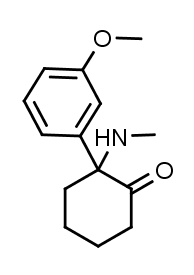Summary
Methoxetamine, which is also recognized under names such as 3-MeO-2′-Oxo-PCM, MXM, and MMXE, belongs to the arylcyclohexylamine class of dissociative anesthetics. It shares close structural similarities with substances like methoxetamine and methoxetamine. Methoxetamine has gained popularity as a designer drug available for purchase on the internet.
| Identifiers | |
|---|---|
| IUPAC name | |
| CAS Number | 1781829-56-8 |
|---|---|
| PubChem CID | 117067863 |
| ChemSpider | 58939253 |
| UNII | U2B6L9JR4L |
| Chemical and physical data | |
| Formula | C14H19NO2 |
| Molar mass | 233.311 g·mol−1 |

FAQ
1. What is Methoxmetamine (MXM)?
Methoxetamine, often abbreviated as MXM, is a dissociative anesthetic belonging to the arylcyclohexylamine class. It is a synthetic compound that shares structural similarities with methoxetamine and methoxetamine.
2. What are the common street names for Methoxmetamine?
Various street names, including Methoxmetamine, 3-MeO-2′-Oxo-PCM, MXM, and MMXE know MXM.
3. How is Methoxmetamine used?
MXM is typically consumed by inhalation, intranasal use, or orally. It’s commonly available in powder or crystalline form. However, it is essential to note that using Methoxmetamine carries potential health risks and legal implications in many countries.
4. Is Methoxmetamine legal?
The legal status of Methoxetamine varies from one country to another. In some regions, it may be classified as a controlled or illegal substance, while in others, it may be unregulated or available for research purposes only. It is essential to check the specific regulations in your area.
5. What are the effects of Methoxmetamine?
The effects of MXM are similar to those of other dissociative anesthetics. Users may experience altered perception, hallucinations, a sense of disconnection from reality, and changes in sensory experiences. The intensity and duration of effects can vary from person to person.
6. What are the potential risks and side effects of using Methoxmetamine?
Methoxetamine use can lead to various adverse effects, including disorientation, confusion, nausea, anxiety, and potential risks to physical and mental health. Long-term use may result in bladder and renal toxicity, among other health issues.
7. Can Methoxmetamine be addictive?
There is limited research on the addictive potential of Methoxetamine, but like other dissociative anesthetics, it may have the potential for psychological dependence. Frequent or heavy use is generally discouraged due to the associated health risks.
8. Is it safe to use Methoxmetamine?
Methoxmetamine’s safety is a subject of concern due to its limited research and potential adverse effects. Using MXM can be risky, and its safety is not guaranteed, primarily when obtained from unregulated sources.
9. Can Methoxmetamine be detected in drug tests?
Methoxetamine is not typically included in standard drug tests. However, specialized tests may be able to detect its presence. It’s essential to be aware of the testing methods used in your specific situation.
10. What should I do if I or someone I know is experiencing adverse effects from Methoxmetamine use?
If you or someone you know is experiencing adverse effects or health concerns related to Methoxmetamine use, seek medical attention immediately. Be honest with healthcare professionals about substance use to ensure proper care and treatment.
11. Where can I find reliable information about Methoxmetamine?
For accurate and up-to-date information on Methoxmetamine, consult trusted sources such as government health agencies, substance abuse prevention organizations, and medical professionals. Always exercise caution and prioritize your safety when researching and considering the use of substances like MXM.
References
- Kaizaki-Mitsumoto A, Noguchi N, Yamaguchi S, Odanaka Y, Matsubayashi S, Kumamoto H, et al. (November 2015). “Three 25-NBOMe-type drugs, three other phenethylamine-type drugs (25I-NBMD, RH34, and escaline), eight cathinone derivatives, and a phencyclidine analog MMXE, newly identified in ingredients of drug products before they were sold on the drug market”. Forensic Toxicology. 34: 108–114. doi:10.1007/s11419-015-0293-6. S2CID45890497.